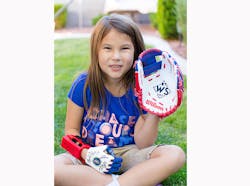Houston has seen more than its share of bad news lately, but now the Astros are in the World Series and hosting Game 4 on Saturday. Which is really awesome news, made better because they get to see seven-year-old Hailey Dawson, born with Poland Syndrome, throw out the first pitch with her 3D-printed prosthetic hand.
It's actually her third first pitch in an MLB park, and thanks to a viral tweet from Bleacher Report, every major league team wants Hailey to throw out the first pitch. Read our detailed story here.
We've been following Hailey's exploits since 2015, when she made national news for throwing out the first pitch at a Baltimore Orioles game with her custom designed Flexy-Hand 2. It was made by UNLV engineering students with a Stratasys Fortus 250mc 3D Printer. The Howard R. Hughes College of Engineering produced the functional artificial extremity for $200, as opposed to the typical cost of $20,000 to $30,000.
The rare disorder, which affects 1 in 20,000, according to the NHI, was discovered at birth. It caused muscles on her right side to under develop, and led to a right hand with stunted digits It never kept Hailey from living a full life, but riding a bike or throwing a ball would not be possible until she was done growing and could get a prosthetic hand. Insurance also usually doesn't cover arm prosthetics, because insurance companies are evidently run by horrible monsters.
But with the engineering department's help,and her mother Yong's determination, Hailey didn't just live a normal life, but an extraordinary one, teaching people about 3D-printed innovations and having a blast while doing it.
Then, this past summer, she threw out the first pitch for the Washington Nationals, thanks in large part to superstar Bryce Harper, who is also from the Las Vegas area, after he learned about Hailey through Twitter.
With two pitches, she won tens of thousands of hearts while also spreading major awareness about what 3D printing can do. After the viral tweet, Major League Baseball invited her to throw out the fisrst pitch of game four. Soon millions more will be hit right in the feels.
Relatively speaking, the amount of people using 3D printers is minuscule considering the impact they can have for the small cost. The Victoria Hand Project out of Canada works with war-torn Guatemalan and Nepalese amputees to provide prosthetics with the Ultimaker² for around $200. In those regions eight out of 10 amputees become that way through trauma.
"The beauty of 3D printing and why it's so popular with the prosthetics, especially with young kids, is they can customize and change quickly as these young kids grow," says Jesse Roitenberg, an education manager for Stratasys. "They're not going back and doing a new mold or a totally different process. They're able to scan, 3D-print, and modify it as it changes. Or, if she she bumps her hand and a part breaks, it can be reprinted."
And as game-changing as the tech is, it's the people who will employ it that is important.
"The real feel good story is that people are willing to go other ways spend their time and their money and make somebody's life better," Roitenberg says
For example, there's Albert Manero, a University of Central Florida grad student and founder of Limbitless, who combined myoelectric sensors and 3D-printed arms to create bionics reactive to muscle twitches. It also created moments like this for kids:
This 2015 video has been viewed 10 million times, and made huge strides in promoting less traditional uses for additive manufacturing. The World Series is a much bigger stage and will reach even more people.
"We are thrilled for Hailey and her chasing her dream," Manero says. "It will encourage so many other kids and be a huge moment for advancing inclusivity."
Hailey throwing out the first pitch is the perfect use case, and teachable moment, to explain the benefits to manufacturing, and humankind in general. Decades from now, many in the next generation of engineers could point to as the moment when they learned anything was possible with 3D printing.
"It should open the open their eyes to a different avenue to get stuff done," Roitenberg says. The former STEM teacher goes across the country to schools and universities evangelizing 3D printing to the students in various disciplines and one thing holds true every time: "When kids realize what engineering actually is, they realize that they can solve problems," he says.
Problems are certainly not in short supply throughout the world, and a future with less of them is something we're looking forward to.
What that future will look like, none of us knows. You can be sure, though, that to these engineers, even the most advanced and productive among our industrial brethren will seem antiquated and lethargic; hipsters in 2050 will be using your tech ironically. And they'll remember Hailey's story, which culminated on a late October day Houston.
For Hailey,this is just the third of 30 times she will trot out to the mound. For everyone else, it will be a chance to see that there isn't a problem we can't solve with good people and great technology.
For the full story in pictures, continue by clicking on the gallery:
About the Author
John Hitch
Editor, Fleet Maintenance
John Hitch, based out of Cleveland, Ohio, is the editor of Fleet Maintenance, a B2B magazine that addresses the service needs for all commercial vehicle makes and models (Classes 1-8), ranging from shop management strategies to the latest tools to enhance uptime.
He previously wrote about equipment and fleet operations and management for FleetOwner, and prior to that, manufacturing and advanced technology for IndustryWeek and New Equipment Digest. He is an award-winning journalist and former sonar technician aboard a nuclear-powered submarine where he served honorably aboard the fast-attack submarine USS Oklahoma City (SSN-723).

